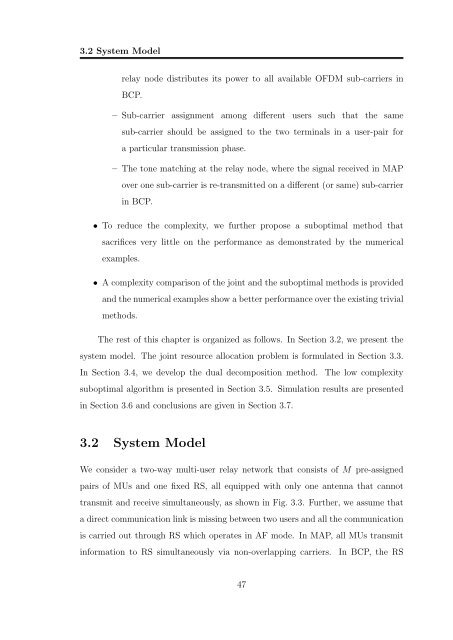Resource Allocation in OFDM Based Wireless Relay Networks ...
Resource Allocation in OFDM Based Wireless Relay Networks ...
Resource Allocation in OFDM Based Wireless Relay Networks ...
You also want an ePaper? Increase the reach of your titles
YUMPU automatically turns print PDFs into web optimized ePapers that Google loves.
3.2 System Model<br />
relay node distributes its power to all available <strong>OFDM</strong> sub-carriers <strong>in</strong><br />
BCP.<br />
– Sub-carrier assignment among different users such that the same<br />
sub-carrier should be assigned to the two term<strong>in</strong>als <strong>in</strong> a user-pair for<br />
a particular transmission phase.<br />
– The tone match<strong>in</strong>g at the relay node, where the signal received <strong>in</strong> MAP<br />
over one sub-carrier is re-transmitted on a different (or same) sub-carrier<br />
<strong>in</strong> BCP.<br />
• To reduce the complexity, we further propose a suboptimal method that<br />
sacrifices very little on the performance as demonstrated by the numerical<br />
examples.<br />
• A complexity comparison of the jo<strong>in</strong>t and the suboptimal methods is provided<br />
and the numerical examples show a better performance over the exist<strong>in</strong>g trivial<br />
methods.<br />
The rest of this chapter is organized as follows. In Section 3.2, we present the<br />
system model. The jo<strong>in</strong>t resource allocation problem is formulated <strong>in</strong> Section 3.3.<br />
In Section 3.4, we develop the dual decomposition method. The low complexity<br />
suboptimal algorithm is presented <strong>in</strong> Section 3.5. Simulation results are presented<br />
<strong>in</strong> Section 3.6 and conclusions are given <strong>in</strong> Section 3.7.<br />
3.2 System Model<br />
We consider a two-way multi-user relay network that consists of M pre-assigned<br />
pairs of MUs and one fixed RS, all equipped with only one antenna that cannot<br />
transmit and receive simultaneously, as shown <strong>in</strong> Fig. 3.3. Further, we assume that<br />
a direct communication l<strong>in</strong>k is miss<strong>in</strong>g between two users and all the communication<br />
is carried out through RS which operates <strong>in</strong> AF mode. In MAP, all MUs transmit<br />
<strong>in</strong>formation to RS simultaneously via non-overlapp<strong>in</strong>g carriers. In BCP, the RS<br />
47

















